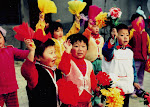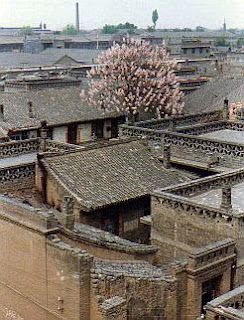 |
A moment to the Silk Road in Xi'an,
where the trade route started in China |
We hope to go to China next fall - my husband wants to celebrate our 10th wedding anniversary there. (We celebrated it there in 2008 with dinner at our friends' house, as well as with a trip to the Great Wall and dinner the next night at Peking duck restaurant.)
I've already started doing research on things we want to do while we're there. My husband's never been to Xi'an to see the Terra Cotta warriors, so that is a high priority for him. I've been there twice and - gasp! - think they're overrated, but Xi'an has a lot of other things to see and do. I've never been to the Shaanxi Provincial Museum, but have heard it's quite fabulous. I've also enjoyed my visits to the city wall, Big Wild Goose Pagoda and the Muslim district.
Ctrip seems to have very reasonably priced packages for a four-day trip to Xi'an which includes airfare from Beijing or Shanghai. Ctrip is a Chinese version of Expedia, and also has an English site. Has anyone ever used it? I'd be interested in your comments. As Xi'an's airport is so far out of town (about an hour's drive) I was hoping to take the train. There's an express train which makes the trip in under seven hours, though an overnight train ride isn't that bad, and you arrive in downtown Xi'an. I'm thinking we'll fly to Shanghai from there because I'm not too keen on a 15- to 24-hour ride on the train, especially when flying is not that much more expensive.
But getting back from China already is proving to be a challenge. Our preferred carrier is United which has non-stop flights from Pasco, Washington (our nearest big airport) to San Francisco, where you catch a nonstop to Beijing. Coming back, the nonstop from Beijing gets in about a half-an hour after the morning flight to Pasco. The next one isn't until night. Last year, United wouldn't let us spend the day in San Francisco. Instead, they routed us to Los Angles, where we had a couple of hours layover, and then to Denver, where we had another layover, before flying us to Pasco. I am not willing to go through that again, if schedules haven't changed by then.
A few tunes in the past, we've driven to Portland or Seattle because of the better connections. Going isn't that bad, but a four-hour drive coming back is tiring on top of the very tiring trans-Pacific flight. If the planes landed in late afternoon or evening, we spend the night in Seattle or Portland, but when they land in early morning, it seems stupid to get a motel to sleep for a few hours, so we hit the road, taking turns driving while the other person sleeps.
Which brings us to Delta, a carrier we hate to fly, but is the only other option for us if we want to leave from Pasco. It has beautiful connections: Seattle and then non-stop to Being both ways. Delta also still doesn't charge for the first two bags, while United only allows one free bag on trans-Pacific flights. One bad isn't a problem going, but my husband does so much shopping over there, he has to buy a suitcase to carry it all back.
I was looking at Delta's website last night, and one thing concerned me: their notice that fares change constantly, and that the price you see may not be the price you pay, as fares could change between the time you hit "book it" and your credit card is charged. Has anyone had this happen to them? Tell me about it! I'm assuming fares will only go up with this process.
Of course, all of this may very well be a moot point by the time we're ready to make our trip. I probably won't do any more planning until next summer when I start looking at air fares again. I tend to overplan in advance, but I think it makes it easier when it's time to do the real thing.
Are you going to China?
If you're planning a trip to China, please see my
website, and feel free to
email me if you have any questions about travel in China.
 This year we will celebrate two New Year's Days in January. The first is January 1, the start of a new calendar year. The second in January 23, which is Chinese New Year's, also known as Spring Festival. The date is flexible, as it is based on a lunar calendar, occurring on the second new moon after the winter solstice. Some years the holiday is celebrated in January, other years it takes place in February.
This year we will celebrate two New Year's Days in January. The first is January 1, the start of a new calendar year. The second in January 23, which is Chinese New Year's, also known as Spring Festival. The date is flexible, as it is based on a lunar calendar, occurring on the second new moon after the winter solstice. Some years the holiday is celebrated in January, other years it takes place in February.


















